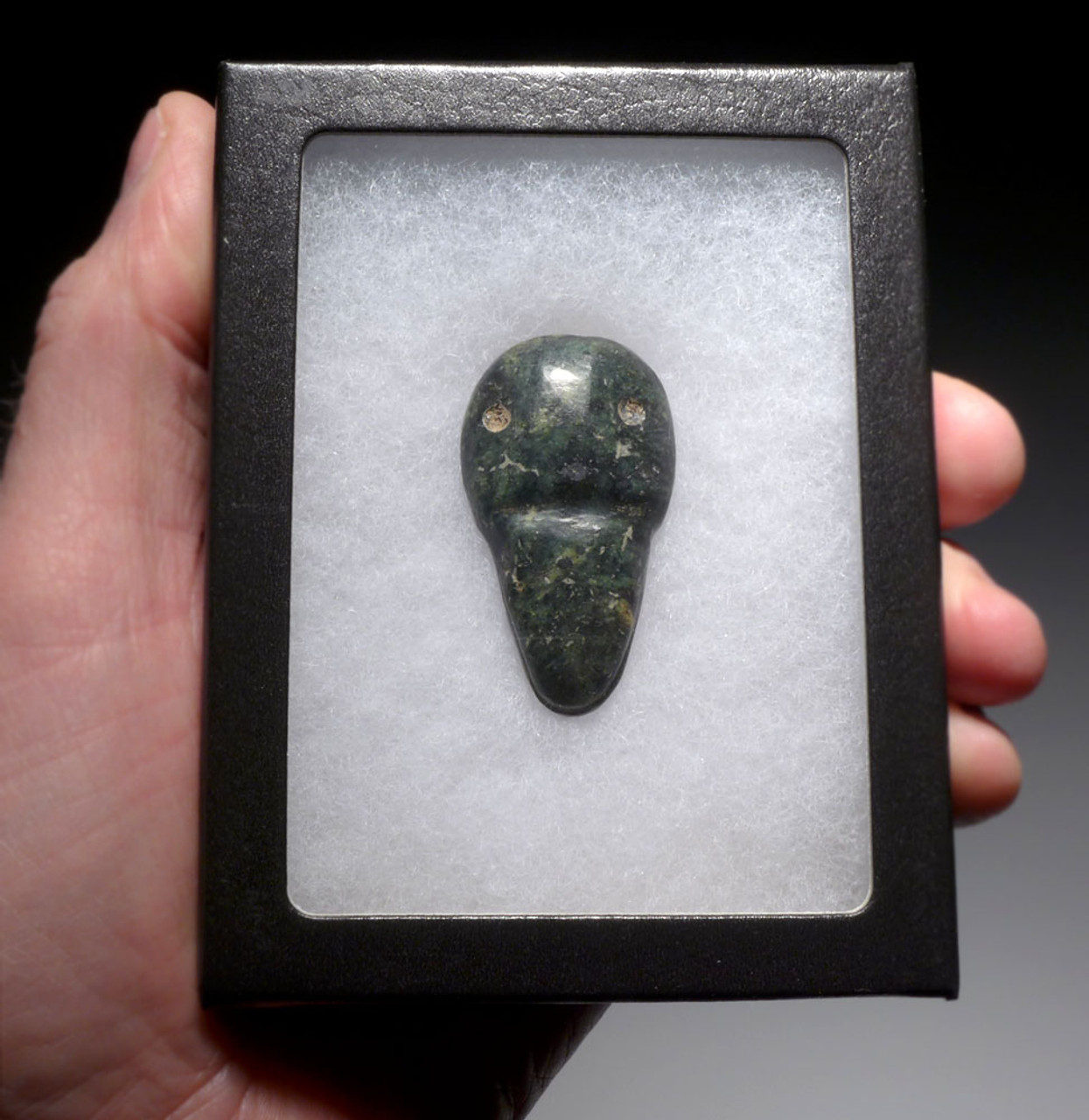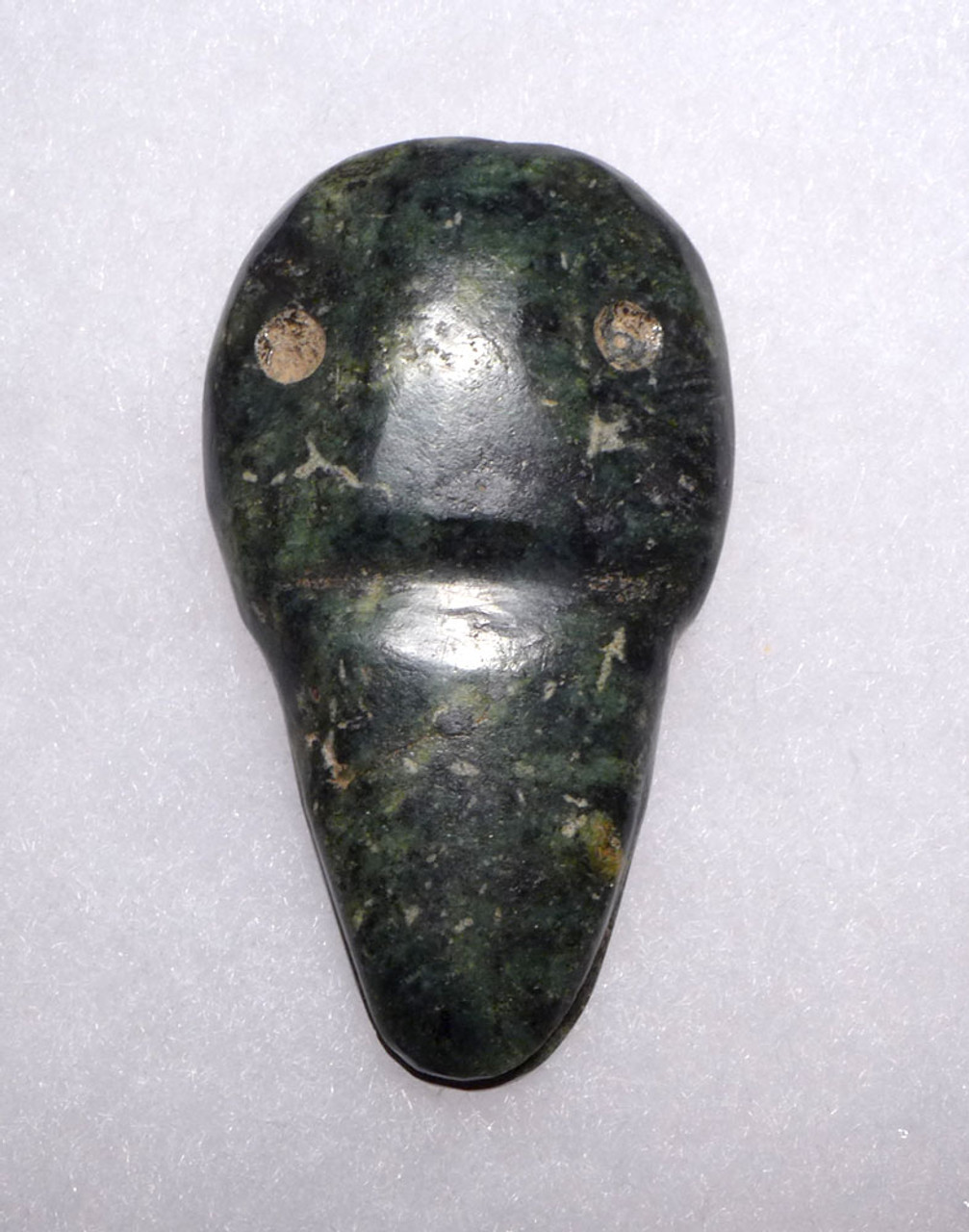Product Description
SEE MORE PRE-COLUMBIAN ARTIFACTS
Pre-Columbian cultures in Central America valued jade more than any other substance including gold. This unusual crocodile carved and pierced deity pendant comes from the Greater Nicoya Pre-Columbian Culture. Whereas clay objects could be made with relative lack of special skills, and produced in high volumes, carved and polished stone art objects required much more expertise and time to produce. Furthermore, because of the extreme value placed on materials such as jade and serpentine, only the finest carvers were allowed to work with the material. The end result of this practice meant that carved and polished jade objects were ONLY within reach of the most wealthy and noble classes of Pre-Columbian tribes.
Uniquely drilled from the top and connected through the back, this beautifully made pendant represents one of the most feared and respected apex predators that lived in the region - the crocodile. Cared details reveal eyes and a mouth yet, in a stylized rendition. The richly colored mottled green jade possesses a beautiful depth and gloss. The original lustrous polish is still intact and well-preserved. The workmanship on this ancient masterpiece is perfectly preserved as originally made. It is safe and solid to wear even today! Minute crevices and perforated holes still impacted with original mineral sediment - a trait ONLY seen in AUTHENTIC specimens such as this example.
Pieces like this were not simply every-day routine items, they were considered the treasure of the owner in their time and today, the same perspective is true. Scientific excavations show very few carved gem stone objects like this. Most definitely an object of extreme status or wealth amongst the Nicoya.
HISTORY
Pre-Columbian Indians considered jade much more valuable than gold. When Spanish explorers first made contact with several tribes, there are records note the surprise amongst various indigenous cultures, wondering why the explorers were more interested in the gold rather than the jade. Jade objects in Pre-Columbian cultures were considered the most precious and hence, displays of nobility and wealth.
In some Mesoamerican Pre-Columbian Cultures, axe-like anthropomorphic pendants called "Axe Gods", can be found, often resembling a sharpened celt axe at the base and having features of some type of deity or figure.
This piece is attributed to the Greater Nicoya Pre-Columbian Culture. This archaeological culture prevailed in the area of Latin America comprising the far southwestern coastal region of Honduras, the far northwestern Pacific coastal region of Costa Rica and the Pacific side of coastal Nicaragua. This Indian culture thrived for many centuries before the first Spanish explorers made contact around 1500 A.D.. The people had no written language but spoke Nahuatl and had continual contact with the Aztec (Mexica) Indians of Central Mexico. The Gran Nicoya culture included many beautiful designs incorporating a variety of different mammals, reptiles and amphibians in effigy pieces. Their pottery is also known for complex glyph-like painted decorations. In the first 500 to 600 years A.D., resources became low as populations grew and warfare become increasingly evident. Tribes in this region practiced head-hunting and victim sacrifice in their warfare.
WARNING: There is an ALARMING number of fake ancient artifacts on the market. As fine quality intact, original specimens become more scarce and techniques have become more sophisticated to fake these artifacts. We have personally handled numerous extremely well-done fakes with extremely convincing patinas. The degree to which the fakers have been able to replicate patina to disguise their work requires an expert examination by highly experienced individuals. Like all rare collectibles, fakes plague the market. Deal only with sources that are extremely knowledgeable in forgeries or altered pieces and get a written guarantee of authenticity that has no conditions or expiration period. We include this guarantee in writing with every item we sell. All purchases should include from the dealer a written guarantee of authenticity with unconditional and lifetime return policies regarding such guarantee.
 US DOLLAR
US DOLLAR
 EURO
EURO
 AUSTRALIAN DOLLAR
AUSTRALIAN DOLLAR
 CANADIAN DOLLAR
CANADIAN DOLLAR
 POUND STERLING
POUND STERLING






















